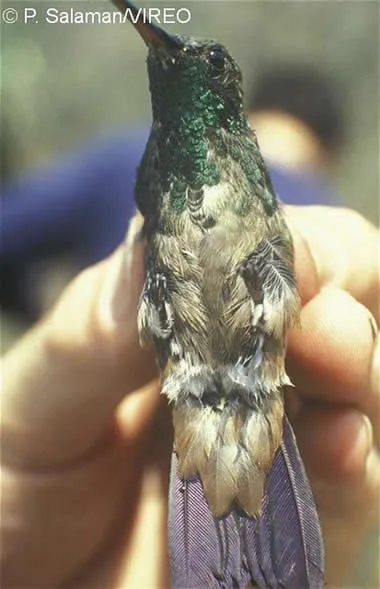
Green-bellied Hummingbird
[order] Apodiformes | [family] Trochilidae | [latin] Saucerottia viridigaster | [UK] Green-bellied Hummingbird | [FR] Ariane a ventre vert | [DE] Grunbauchamazilie | [ES] Amazilia de Cola Morada | [IT] Amazilia ventreverde | [NL] Groenbuikamazilia
Subspecies
| Genus | Species | subspecies | Breeding Range | Breeding Range 2 | Non Breeding Range |
| Amazilia | viridigaster | SA | Colombia, w Venezuela | ||
| Amazilia | viridigaster | cupreicauda | tepuis of s Venezuela, w Guyana and Roraima (nc Brazil) | ||
| Amazilia | viridigaster | duidae | Mt. Duida (s Venezuela) | ||
| Amazilia | viridigaster | iodura | w Venezuela | ||
| Amazilia | viridigaster | laireti | Sierra de Unturán and Cerro de la Neblina (tepuis of s Venezuela) | ||
| Amazilia | viridigaster | pacaraimae | Sierra de Pacaraima (mts. of s Venezuela) | ||
| Amazilia | viridigaster | viridigaster | nc Colombia |
Physical charateristics
Forehead, sides of head, throat and breast emerald green. Crwon, nape and wing coverts bronze green changing to rufous brown on rump and uppertails. Wings dull black, slightly forked small tail, lower belly greyish brown. Bill moderately long and black, basal half of lower mandible pink. Legs black. Sexes are similar.
Listen to the sound of Green-bellied Hummingbird
[audio:http://www.aviflevoland.nl/sounddb/G/Green-bellied Hummingbird.mp3]
Copyright remark: Most sounds derived from xeno-canto
| wingspan min.: | 11 | cm | wingspan max.: | 12 | cm |
| size min.: | 8 | cm | size max.: | 9 | cm |
| incubation min.: | 0 | days | incubation max.: | 0 | days |
| fledging min.: | 0 | days | fledging max.: | 0 | days |
| broods: | 0 | eggs min.: | 1 | ||
| eggs max.: | 3 |
Range
Found in Venezuela, the Guianas and northern Brazil. In Suriname only one record at the southern Brazilian border (Sipaliwini)
Habitat
Edges of lowland and sub-montane evergreen forest, second growth and also plantations.
Reproduction
Hardly any data available. Clutch size is 2 eggs incubated by female. Probably breeds in October to January
Feeding habits
Their food is nectar, taken from a variety of shrub and low tree flowers, and some small invertebrates which are caught by hawking.
Conservation
This species has an estimated global extent of occurrence of 43,000 km2. The global population size has not been quantified, but it is believed to be large as the species is described as ‘frequent’ in at least parts of its range (Stotz et al. 1996). Global population trends have not been quantified, but the species is not believed to approach the thresholds for the population decline criterion of the IUCN Red List (i.e., declining more than 30% in ten years or three generations). For these reasons, the species is evaluated as Least Concern.

Migration
Probably some local movement, poorly known
Distribution map

]]>
